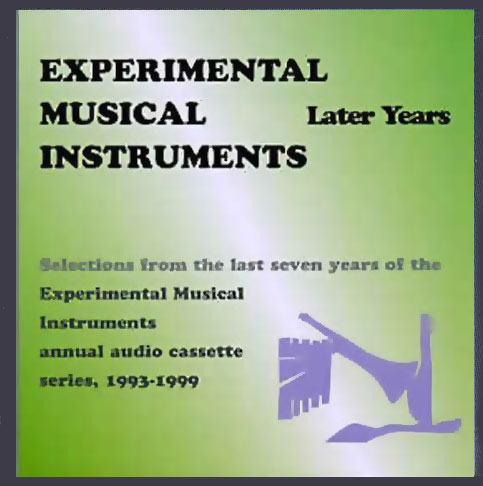Experimental Musical Instruments – Later Years
Audio CD with 16-page insert booklet.
Published by Experimental Musical Instruments in 2002.
Later Years is the second of a pair of CDs containing selections from the Experimental Musical Instruments annual audio cassette series that ran from 1985 – 1999. (The other, called Early Years, is described here.) Later Years covers the years from 1993-1999. The original cassettes from those years are sold out. This CD brings them back to life by making 17 selected tracks available again, recapturing the vitality and variety of those early releases. The package includes a sixteen-page booklet containing the original notes followed by short updates on most of the artists and their work. The master tapes have been digitally remastered, and the sound quality on the CDs is better than that of the original cassettes.
Complete contents for the Later Years CD are listed below, along with audio samples. But first, here are teasers for a few of the selections:
A mouthbow is a single-stringed instrument analogous to a jaw harp, in which the player uses mouth resonances to bring out melodies in shifting overtones within the string sound. In this CD Wayland Harman plays his specially developed mouthbow, designed to highlight mouth-resonance tones with much more clarity and strength than happens with traditional designs.
John Gzowski’s Cat’s Cradle is — well, it has too many distinctive features to describe them all here, but essentially it’s a string instrument with an extraordinary electro-acoustic feedback system that recycles pitch-bent string resonances through the sound for an extraordinarily rich and complex timbre.
The Stroh violin was a horned, pivot-and-diaphragm-driven violin developed in the early days of acoustic (pre-electric) sound recording for use with Edison’s early recording machines. On this CD you’ll hear a Stroh violin as recently recorded on a perfectly preserved Edison phonograph.
The Ex-Pensives were an early-90s grunge group playing archetypally primitive music on homemade instruments with homemade pickups.
In 1904, J.C. Deagan patented his organ chimes, essentially a metal angklung set on a monumental scale. Each chime-frame contained four chimes including the octave and the double octave of the main pitch, all with air-resonance tuning. There were enough of these frames for a range of several chromatic octaves, and the instrument as a whole had a beautiful tone. In this CD, Marion B. Cox plays one of the surviving sets with polyphonic virtuosity.
CONTENTS OF THE LATER YEARS: CD:
Barry Hall: “Globularity.” Globular horns (see below for musical excerpt)
Wayland Harman: “String Walk, a Spontaneous Recording.” Reeded Mouthbow (see below for musical excerpt)
Hal Rammel: “Surge and Shape.” Sound Palette
Christopher Lee: “Liebeslied.” Stroh violin
Susan Alexjander & ensemble: “Sequencia Intro.” DNA tunings recreated on synthesizer
Jacques Remus: “Marche Turque” and “Etude (Gyakorlat).” Automatophones
Richard Cooke: “Return to Misty Mountain.” Freenotes
Zeno Okeanos: “Zeno’s Drums.” Polymorphous percussion
Marty Cox: “I’ll Take You Home Again, Kathleen.” Deagan organ chimes
TakeDake: “Spring Breeze (Haru Kaze).” All-bamboo ensemble
John Gzowski: “Variation #5.” Cat’s Cradle
One Ring Zero: “Dead Animals.” Claviola (see below for musical excerpt)
Scot Jenerik: “Modulus of Horizontal Shear.” Sublinear
Henry Lowengard: “Software-o-phones (1994).” Software-o-phones
Bakshish: “Curious.” Instruments with homemade pickups
Linsey Pollak: “Ousak Sunset.” Clarini
The Ex-Pensives: “Angst? (Me Too).” Instruments with homemade pickups
Excerpts from Experimental Musical Instruments – Later Years

